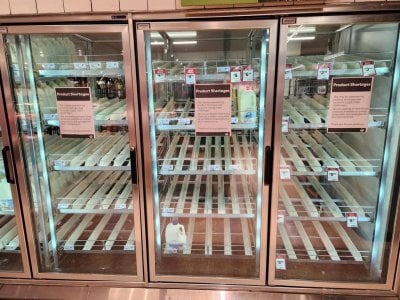Woolworths’ empty shelves spark concern among Aussie shoppers—‘This is a disgrace’
- Replies 10
It's a scene reminiscent of the early days of the pandemic: aisles upon aisles of empty shelves where once there was an abundance of fresh produce, dairy, and meats.
Shoppers across Australia have been met with this disconcerting sight at Woolworths, one of the nation's major supermarkets, leading to a flurry of concern and confusion.
So, what's the cause of this sudden scarcity?
The images that have emerged from various Woolworths stores are indeed startling.
Shelves that would typically be stocked with the freshest fruits, vegetables, and other staples are now ‘completely bare’, leaving shoppers bewildered and frustrated.
It was disclosed earlier that Woolworths shelves were bare in parts of Queensland, with low to no stock available across various fresh produce categories, such as milk, poultry, and fruit.
The cause of the issue was not disclosed, but according to an unnamed worker, the refrigerated section at a major distribution centre in Queensland transitioned to a completely new software package last week.

This was then confirmed by Woolworths Chief Commercial Officer Paul Harker on Monday, May 13, saying the issue had caused ‘carnage’.
‘We’re not particularly happy about the situation,’ Mr Harker stated.
‘We’re working very hard to improve it. We apologise to our customers that we have had issues.’
‘I might add we’re continuing to take the committed stock from our suppliers, even if we can’t get it out,’ he added.
However, although the supermarket chain stated it is striving to ‘resume normal operations as quickly as possible’ and assured shoppers that supplies are ‘expected to see improvement in the coming days’, many customers have expressed frustration at the ‘apocalyptic’ scenes in their local store.
Social media had been abuzz with photographs and comments from disgruntled shoppers.
‘Woolies is empty. This is a disgrace it is,’ one frustrated shopper expressed.
Another shared, ‘[I'm] not sure what is happening with Woolies, but empty shelves are happening in both Woolies Banyo and Woolies Nundah.'
‘A trip to Woolies yesterday afternoon had me wondering why the shelves are practically empty…The bread aisle was empty, the only gluten-free bread I found was out of date and stale,’ a third added.
Queensland shoppers also reported a similar occurrence.
One customer said, ‘Woolworths Richlands had basically nothing left in terms of vegetables, fruit, and deli meats.'
‘Have been noticing reduced options in and around Moreton Bay region,’ another added.
‘No fresh chicken pieces, very little milk at Logan Hyperdome [Woolies] on Friday. Notices up apologising for lack of stock due to supply issues,’ a third shared.
One Gold Coast resident also observed the same thing in her local supermarket, describing it as ‘completely bare’.
There had also been reports of ‘bare fruit, vegetable, and bread shelves at Woolworths across Brisbane, from Nundah to Coorparoo’.
In some areas, the situation was so bad that the stark emptiness of the shelves drew comparisons to the most uncertain days of the COVID-19 crisis.
‘This is giving March 2020 vibes,’ one customer commented.
‘My Woolies was bare yesterday. I thought I must have been the only one who didn’t know the pandemic was back,’ another jokingly said.
‘Guess we’re all going to Coles,’ added a third.
Reports indicated that Coles had not experienced the supply issues seen at Woolworths, and there are currently no product limits in effect.
This came after an electrochemical engineer from the University of Newcastle shed light on the issue, following recent shortages of soft drinks in major supermarkets.
Dr Jess Allen took to social media to explain that Australia is ‘actually running low on carbon dioxide, which is the main ingredient to make a carbonated beverage’.
She went on to clarify that New South Wales is ‘one of the main suppliers of food-grade carbon dioxide’, a common by-product of the ammonia manufacturing process.
However, an unexpected outage at the Orica ammonia manufacturing plant on Kooragang Island in Newcastle disrupted CO2 production, leading to shortages in food and beverage products.
Customers of Coles and Woolworths noticed empty shelves in the soft drink aisle, with both home brand beverages and smaller suppliers like Diet Rite and La Ice cola in short supply.
BOC, one of Australia's two major carbon dioxide suppliers, stated that the issue has been resolved, and full supply has been restored.
The company declared, ‘BOC is committed to increasing long-term carbon dioxide reliability and supply for our customers.'
A new production facility in Longford, Victoria, is close to completion and has the capacity to produce approximately 60,000 tonnes per year of beverage-grade liquid carbon dioxide. It is anticipated to become operational later this year.
On the other hand, the other major supplier, the French group Air Liquide, stated that ‘the nation’s CO2 situation remains tight’, and there were availability issues with sources in Victoria.
‘Air Liquide continues to monitor and manage its storage and supply chain for its customers with a view to minimising the impact to its customers,’ they said.
The carbon dioxide supply issue isn't limited to soft drink production; it's also crucial for making sparkling wine and beer, cooling packaged meat, and in hospital settings.
The recent phenomenon of empty shelves at Woolworths left many shoppers puzzled and frustrated, and they wondered about the causes behind the scarcity of goods.
As efforts to restock continue, the issue persists not only in Woolworths but also in supermarkets across the state, indicating a broader challenge in supply chains.
These shortages extend beyond just food items, affecting various products essential for daily life.
 Have you encountered empty shelves at your local Woolworths? How have you adapted to these challenges? Share your stories in the comments below.
Have you encountered empty shelves at your local Woolworths? How have you adapted to these challenges? Share your stories in the comments below.
Shoppers across Australia have been met with this disconcerting sight at Woolworths, one of the nation's major supermarkets, leading to a flurry of concern and confusion.
So, what's the cause of this sudden scarcity?
The images that have emerged from various Woolworths stores are indeed startling.
Shelves that would typically be stocked with the freshest fruits, vegetables, and other staples are now ‘completely bare’, leaving shoppers bewildered and frustrated.
It was disclosed earlier that Woolworths shelves were bare in parts of Queensland, with low to no stock available across various fresh produce categories, such as milk, poultry, and fruit.
The cause of the issue was not disclosed, but according to an unnamed worker, the refrigerated section at a major distribution centre in Queensland transitioned to a completely new software package last week.

Woolworths faced severe stock shortages across different produce ranges in its stores, resulting in ‘apocalyptic’ bare shelves. Credits: X / @AdenGlaven1994
This was then confirmed by Woolworths Chief Commercial Officer Paul Harker on Monday, May 13, saying the issue had caused ‘carnage’.
‘We’re not particularly happy about the situation,’ Mr Harker stated.
‘We’re working very hard to improve it. We apologise to our customers that we have had issues.’
‘I might add we’re continuing to take the committed stock from our suppliers, even if we can’t get it out,’ he added.
However, although the supermarket chain stated it is striving to ‘resume normal operations as quickly as possible’ and assured shoppers that supplies are ‘expected to see improvement in the coming days’, many customers have expressed frustration at the ‘apocalyptic’ scenes in their local store.
Social media had been abuzz with photographs and comments from disgruntled shoppers.
‘Woolies is empty. This is a disgrace it is,’ one frustrated shopper expressed.
Another shared, ‘[I'm] not sure what is happening with Woolies, but empty shelves are happening in both Woolies Banyo and Woolies Nundah.'
‘A trip to Woolies yesterday afternoon had me wondering why the shelves are practically empty…The bread aisle was empty, the only gluten-free bread I found was out of date and stale,’ a third added.
Queensland shoppers also reported a similar occurrence.
One customer said, ‘Woolworths Richlands had basically nothing left in terms of vegetables, fruit, and deli meats.'
‘Have been noticing reduced options in and around Moreton Bay region,’ another added.
‘No fresh chicken pieces, very little milk at Logan Hyperdome [Woolies] on Friday. Notices up apologising for lack of stock due to supply issues,’ a third shared.
One Gold Coast resident also observed the same thing in her local supermarket, describing it as ‘completely bare’.
There had also been reports of ‘bare fruit, vegetable, and bread shelves at Woolworths across Brisbane, from Nundah to Coorparoo’.
In some areas, the situation was so bad that the stark emptiness of the shelves drew comparisons to the most uncertain days of the COVID-19 crisis.
‘This is giving March 2020 vibes,’ one customer commented.
‘My Woolies was bare yesterday. I thought I must have been the only one who didn’t know the pandemic was back,’ another jokingly said.
‘Guess we’re all going to Coles,’ added a third.
Reports indicated that Coles had not experienced the supply issues seen at Woolworths, and there are currently no product limits in effect.
This came after an electrochemical engineer from the University of Newcastle shed light on the issue, following recent shortages of soft drinks in major supermarkets.
Dr Jess Allen took to social media to explain that Australia is ‘actually running low on carbon dioxide, which is the main ingredient to make a carbonated beverage’.
She went on to clarify that New South Wales is ‘one of the main suppliers of food-grade carbon dioxide’, a common by-product of the ammonia manufacturing process.
However, an unexpected outage at the Orica ammonia manufacturing plant on Kooragang Island in Newcastle disrupted CO2 production, leading to shortages in food and beverage products.
Customers of Coles and Woolworths noticed empty shelves in the soft drink aisle, with both home brand beverages and smaller suppliers like Diet Rite and La Ice cola in short supply.
BOC, one of Australia's two major carbon dioxide suppliers, stated that the issue has been resolved, and full supply has been restored.
The company declared, ‘BOC is committed to increasing long-term carbon dioxide reliability and supply for our customers.'
A new production facility in Longford, Victoria, is close to completion and has the capacity to produce approximately 60,000 tonnes per year of beverage-grade liquid carbon dioxide. It is anticipated to become operational later this year.
On the other hand, the other major supplier, the French group Air Liquide, stated that ‘the nation’s CO2 situation remains tight’, and there were availability issues with sources in Victoria.
‘Air Liquide continues to monitor and manage its storage and supply chain for its customers with a view to minimising the impact to its customers,’ they said.
The carbon dioxide supply issue isn't limited to soft drink production; it's also crucial for making sparkling wine and beer, cooling packaged meat, and in hospital settings.
The recent phenomenon of empty shelves at Woolworths left many shoppers puzzled and frustrated, and they wondered about the causes behind the scarcity of goods.
As efforts to restock continue, the issue persists not only in Woolworths but also in supermarkets across the state, indicating a broader challenge in supply chains.
These shortages extend beyond just food items, affecting various products essential for daily life.
Key Takeaways
- Woolworths had been experiencing severe stock shortages across various produce ranges in its stores, leading to 'apocalyptic' images of bare shelves.
- The stock shortages were attributed to a warehouse management system upgrade at a major distribution centre in Queensland.
- Frustrated customers took to social media to voice their concerns over the empty shelves seen in multiple Woolworths stores.
- While Woolworths was reported to have been working to resume normal operations swiftly, other issues, such as a carbon dioxide shortage, have also been affecting supermarket supplies.







